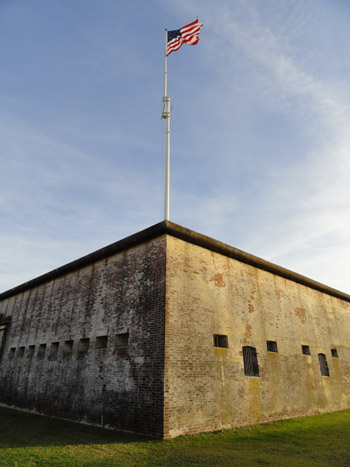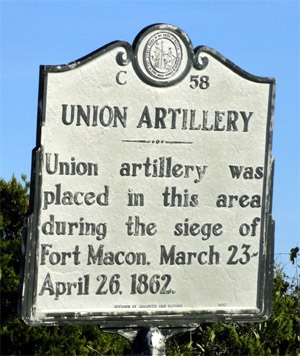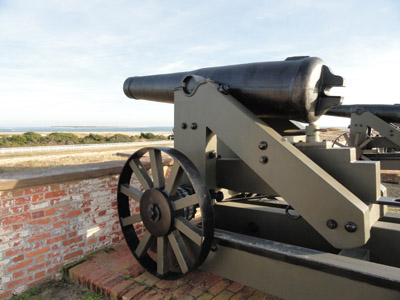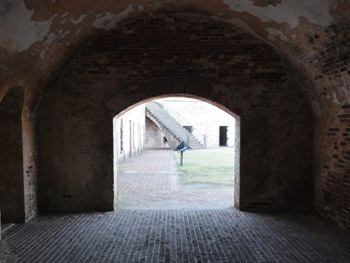 |
Fort Macon
Atlantic Beach, North Carolina
|
|
 |
Constructed: 1826 - 1834
Designed by: Simon Bernard
Used by: United States of America
Conflicts in which it participated:
US Civil War
Second World War (sort of)
|
North Carolina's Outer Banks have a long history of scaliwaggy piracy: Legendary pirate Blackbeard (1680-1718) spent plenty of time sailing about the region, doing piraty things. What is thought to be Blackbeard's ship, Queen Anne's Revenge, has recently been discovered very close to Fort Macon State Park, and is currently being excavated.
Spain, France and Great Britain all sailed aggressively about the Outer Banks as well. The town of Beaufort was captured and plundered by the Spanish in 1747.
|
 |
|
|
Local bigwigs determined that fortification was their only recourse, if they didn't want to be plundered like clockwork every 35 years. Construction of what sounds like a relatively pointless little thing called Fort Dobbs was begun on Bogue Banks in 1756 to defend Beaufort and nearby waters, but this fortification was never completed, and Beaufort was undefended during the American Revolutionary War (1775-1783), which led to another exciting episode of capture 'n' plunder by the British in 1782. Fort Dobbs was named after North Carolina Governor Arthur Dobbs (1689-1765), who apparently demanded that every fortification built in NC be named after him: Another Fort Dobbs was built around the same time on North Carolina's western frontier, near what is now the town of Statesville. That Fort Dobbs was built to protect settlers from Indian threats, and played a small role in the French & Indian War (1754-1763)...but we're not interested in either one of the Fort Dobbses.
|

A pointy corner of Fort Macon. I visited this fort in November of 2012: Click here to see & read about my adventure in the Starforts I've Visited section! |
 |
We're also not particularly interested in Fort Hampton, a small masonry fort that was built 1808-1809 to defend Beaufort Inlet from the continually troublesome British. Fort Hampton's five 18-pounder, two six-pounder and single four-pounder guns went unchallenged during the War of 1812 (1812-1814), and the fort eroded and was then washed away to nothing in 1826. Cya, Fort Hampton.
Beaufort, North Carolina's only major deepwater ocean port, needed some serious defendin', and the US government got serious in 1826, having learned the lesson of what happens when you don't energetically defend your stuff from the Royal Navy (ie: Your capital city gets burned down, as was Washington DC during the War of 1812).
Ground was broken for the construction of Fort Macon in 1826. The fort was named for Nathaniel Macon (1757-1837), a North Carolina Senator who fought bitterly against both the concept of a strong federal government and the creation of a US Navy, which he (loudly) considered an unnecessary expense. Doubtless, the Confederate troops manning Fort Macon in 1862 held similar views as they were being pounded into oblivion by the US Navy.
|
|
Fort Macon was completed in December of 1834, and immediately garrisoned. In the 1840's a US Army Engineer named Robert E. Lee (1807-1870) worked on the fort's anti-erosion system. Busybody Bobby Lee also built Fort Washington's caponniere in the same era, among other forty things.
|
The US Civil War (1861-1865) began officially on April 12, 1861. Two days later, North Carolina militia swooped down from Beaufort and took Fort Macon from what one imagines was a relatively puny federal garrison. The Confederacy mounted 54 heavy guns and hunkered down behind Fort Macon's walls.
...for just barely over a year, when Union troops under Brigadier General John G. Parke (1827-1900) arrived on Bogue Banks to take it back. For eleven hours on April 25 1862, four Union gunboats, a couple of floating batteries and heavy siege guns (mounted where that sign to the right is) bashed at Fort Macon. The fort's 400 defenders would have been able to sit out the gunboats' and floating batteries' relatively inaccurate fire, but the Federal siege guns firing from down the beach were new rifled cannon. This heavy, accurate fire was devastating, and the fort's defenders surrendered on the morning of April 26. For the rest of the war, Fort Macon served as a coaling station for the US Navy. |
 |
 |
|
North Carolina after the Civil War found itself in desperate need of places to securely keep arrested persons, so Fort Macon was used as a military and civil prison until 1877. Fort Macon was decommissioned that year, and sat quietly under the eye of a single caretaker until the wicked, warmongering Spanish forced the peaceful, flower-contemplating US into the Spanish-American War in 1898.
|

A smoothbore Model 1841 Navy 32-pounder at Fort Macon
(okay it's a replica!) |
 |
Beaufort Harbor wasn't considered to be a particularly irresistible target for the wholly imagined ravaging Spanish Navy, but all US seacoast fortifications were manned in 1898 just in case Spain really did have a navy capable of inflicting damage to anything more advanced than small collections of dudes with bows 'n' arrows. US forts at strategic locations were disfigured with millions of tons of concrete and retrofitted with the latest in rapid-fire armament, but engineers at Fort Macon just remounted two rifled 100-pound Parrot Guns, two 10-inch siege mortars and two 12-pounder field guns, left over from the Civil War. The Spanish never came out to play, contenting themselves with being massacred at Manila Bay and other non-American places.
|
|
Fort Macon was again left under the care of a single ordnance sergeant, acting as caretaker, until 1903. Whatever Sarge was doing in his caretaking role didn't include cutting the grass, however, and the elements encroached. Nobody bothered manning Fort Macon during the First World War (1914-1918), mainly because all they found when they went looking for it was a big ole bushy mess.
In 1924 the US Army moved to divest itself of a bunch of its obsolete forts, and sold Fort Macon to the state of North Carolina for a whopping $1. NC created Fort Macon State Park, its second state park after Mount Mitchell State Park, which was established in 1916.
|
Having made this massive investment, North Carolina realized it had no money left to make Fort Macon State Park into...a functioning State Park! Riding to the rescue came the Civilian Conservation Corps during the Great Depression of the 1930's. The otherwise unemployed young men of the CCC worked at Fort Macon from April 1934 to October 1935, making what had been a giant pile of weeds into a place one might wish to visit.
Just in time for the Second World War (1939-1945)! German U-Boats started sinking US and Allied shipping just off of North Carolina's coast in an alarming fashion in December of 1941. |
 |
 |
|
Back into Fort Macon swooshed the US Army! Germany would sink or damage over 100 Allied ships off of North Carolina by November of 1944, when the U-Boat threat was finally considered over. In the meantime, ten 155mm guns were mounted at and around Fort Macon, in addition to a few smaller guns, in an effort to defend the coast from any kooky thoughts of invasion or harassment that the Nazis might have planned. No Nazis attacked Fort Macon, but the last shot of the Civil War was "fired" there during WWII. US Coast Artillery troops stationed at Fort Macon rolled cannonballs into fireplaces for use as andirons (generally iron bars upon which logs are laid for more efficient burning), and on at least one occasion a cannonball used in such fashion was not solid iron shot, but still filled with gunpowder from the Civil War. The ball exploded, killing two soldiers, at least one of whom was hopefully the idiot ball selector. Fort Macon was handed back over to North Carolina on October 1st, 1946. Today it's a fabulously preserved fragment of American history. I visited this fort in November of 2012 and had a delightful time scampering freely in and around it. Those with a keen eye may have noticed that Fort Macon isn't a starfort by any stretch of the imagination...but it's a great US Third System coastal fort, and I have granted it Honorary Starfort status. There, THAT oughta get all those starfort purists off my back! I visited Fort Macon on November 30, 2012. Won't you please visit the Fort Macon page in the Starforts I've Visited section?
|
|
|
|
|
|
 |




